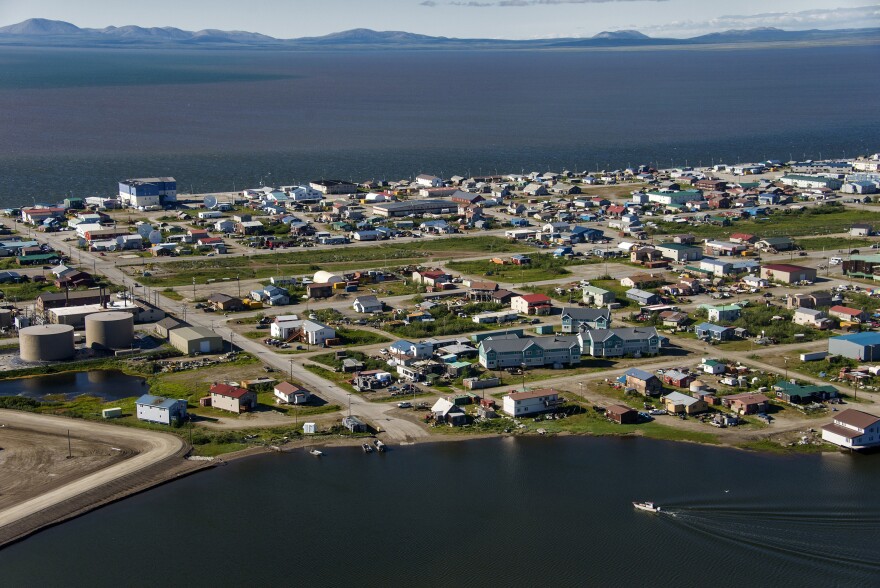Updated December 22, 2022 at 5:06 PM ET
The Arctic is warming faster than any place on earth. For Indigenous communities in Alaska, that means adapting to the changing climate, or moving elsewhere.
"Alaska Native communities and our people are on the front lines of climate change," says Jackie Qataliña Schaeffer, who co-authored a recent federal report on Arctic warming. Schaeffer, an Inupiaq from the coastal community of Kotzebue, has seen her home change drastically over the decades.
"I grew up on a rocky beach where all our subsistence activities took place," she says. Over time, the beach began to erode, a seawall was built, but that hasn't insulated her community from flooding as the climate warms.
"The Arctic itself, you have to consider it the cooling system for the planet," Schaeffer says.
A cooling system indeed. A strong Arctic high pressure system is sweeping across much of the United States this week, and bringing with it bitter cold. More broadly, snow and ice in the Arctic reflect the Sun's heat and help control the temperature of the entire globe. But climate change is causing that snow and ice to disappear.
National Oceanic and Atmospheric Administration director Rick Spinrad recently warned that what's happening in the Arctic now – the dramatic warming – could forecast what's to come for the rest of the globe. Once consistently frigid and frozen, over the decades the Arctic has become wetter and stormier – and threatened the health and livelihoods of Native communities.
In September 2022, typhoon Merbok revealed "the inextricable linkage of environmental change and impacts on human safety, food security, and health," according to the report from NOAA. "The storm – fueled by unusually warm water in the subtropical North Pacific Ocean – flooded several Bering Sea communities; damaged or destroyed homes, hunting camps, boats, and other subsistence infrastructure."
It was the strongest storm to hit Alaska in decades.
With the loss of sea ice, coastal communities have been inundated with flooding. Many of these communities are remote and "logistically removed from the road system," Schaeffer says, accessible only by boat or plane.
Thawing ice, more severe storms, and wildfires are already risking public health, food and water security and even spirituality and cultural traditions tied to the land.
Schaeffer, who serves as director of climate initiatives for the Alaska Native Tribal Health Consortium, collaborated with dozens of others in a study of environmental change in the Arctic.
"Arctic Indigenous Peoples interact intimately with their environments," their report states. "For example, the distribution, quality, thickness, and timing of ice on the ocean, lakes, and rivers drive nearly every aspect of life on Arctic coasts, from boating to whaling and seal hunting to the safety of fishing and foraging."
Relocation is an option, Schaeffer says, but it's not so easily accomplished.
"It's not like we have the privilege of migrating away from danger anymore, because of land designation and landownership. Working with federal partners is important because 65% of Alaska is federal land," she adds. "And so we have to look at it now through a different lens."
In many Indigenous communities, anywhere from 60 to 80% of households depend on wildlife for food. "And so when climate changes that land base, now those things are compromised," Schaeffer says.
But Schaeffer is hopeful. She sees solutions in aligning Indigenous and scientific knowledge.
"Indigenous people have this symbiotic dance with nature," Schaeffer says. "We are constantly in nature. Every season...there's some type of traditional activity that's attached to seasonal change."
Earlier this month, three Tribal communities in Alaska and Washington that have been severely impacted by climate change received $75 million from the Biden administration to help relocate to higher ground.
Schaeffer says finding solutions requires a shift in how we look at and interact with the planet. It is a lesson that can be learned from Indigenous people who have survived, and continue to survive, amid ever-accumulating crises.
Preserving coastal communities requires some engineering, whether constructing seawallsor safeguarding land from further erosion. But in some cases, mitigation measures are not enough, and relocation to higher ground is necessary to evade the rising seas.
"We try to remind our communities that just a few centuries ago we were all migratory," Schaeffer says.
The audio interview was edited by Amra Pasic. Rebecca Hersher contributed. The digital story was edited by Majd Al-Waheidi. contributed to this story
Copyright 2022 NPR. To see more, visit https://www.npr.org.



